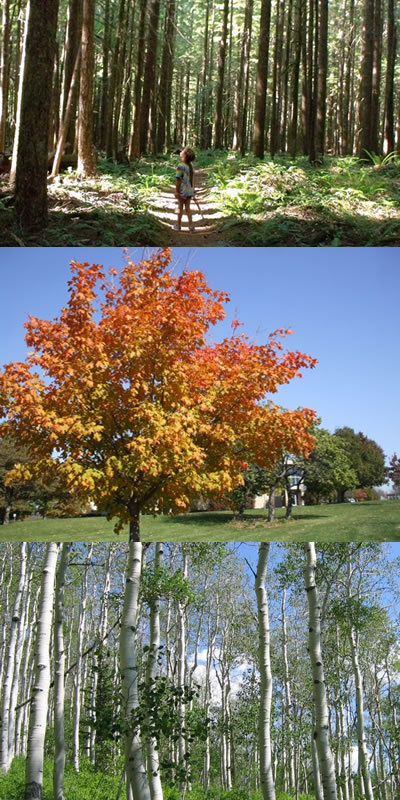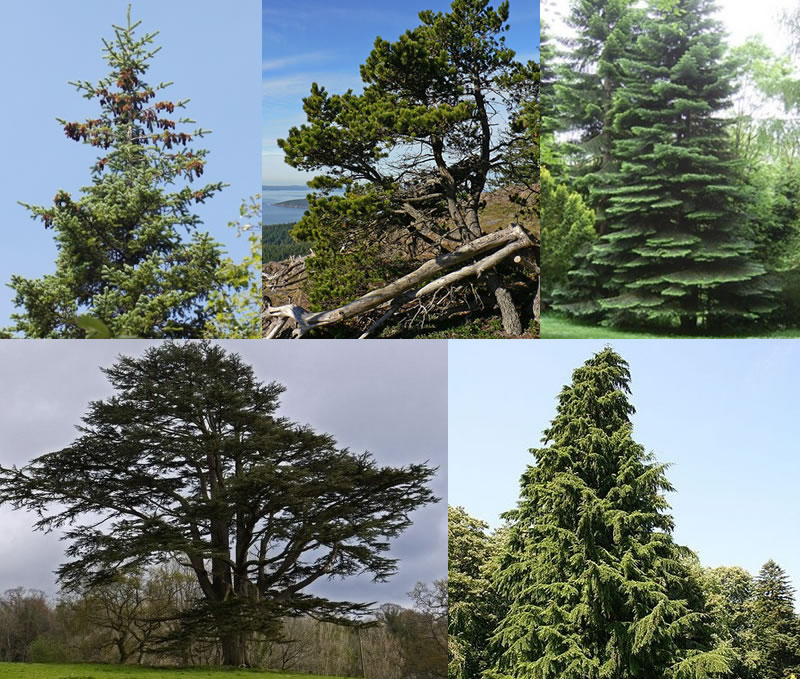6. Forestry in British Columbia
Introduction
British Columbia’s forests are legendary. BC forests have been the economic, cultural and political lifeblood of the province – from the intimate relationships of First Nations with the life-sustaining cedar and sacred trees like the Golden Spruce, to the harrowing tales of lumberjacks among the towering evergreens of the coast, to the role of BC forests in feeding the military during war, and to the now-familiar boom-and-bust cycles of lumber towns like Chemainus.
Despite the heavy use of this resource, only 60% of the province is forested, which represents approximately 55 million of the province’s 95 million hectares. Three percent of areas that were formerly forests have been permanently converted to other land uses, such as towns, urban areas or agriculture. The forest is a public resource as about 95% percent of the forested area is provincially owned.
Forestry is a vital part of the province’s economy. Currently, one in five jobs in BC is related to forestry. Employment in the industry is growing with direct and indirect employment sitting just below 170,000 in 2012. Although the forest sector has experienced some declines, with an average annual growth rate of 1.7% it is forecast to be one of three sectors to experience the fastest growth from 2007 to 2017.
In 2004, lumber production peaked at 85 million cubic metres of lumber produced at sawmills, but by 2009 there was a decline to about 45 million cubic metre. The socioeconomic implication of this downfall was harmful to large parts of the economy and to several communities that were devastated by the closing of sawmills. Since then, the industry has slightly recovered and future prediction estimates a continued slow recovery. Despite the 2009 slowdown of the lumber industry, BC’s global exports in wood products totalled $7,745,000, and pulp and paper exports were at $3,909,000, constituting 33% constituting 33 percent of BC’s overall commodity exports (BC Stats, 2014).
The province has adopted the western red cedar as its official tree, reflecting its importance to the indigenous communities and to the economic growth of the province. However, to best understand the background of forestry in BC it is important to overview some of the many important native tree species. The BC Tree Book [1] outlines 40 different native tree species that can be divided into two broad categories: deciduous trees and coniferous trees.
Deciduous Trees (Hardwood)
Deciduous means “falling off at maturity” and entails the natural process of dropping a plant part that is no longer needed. It is used to describe trees and shrubs that lose their leaves seasonally (commonly during autumn) and to plants that lose their petals after flowering or fruit when ripe. Deciduous trees in British Columbia usually are rapid growers that come immediately after the destruction of the forest by natural causes such as fire, infestation or natural decay. The most common species of deciduous trees in British Columbia are elder, maple and birch.

Coniferous trees (Softwood)
Coniferous trees make up the majority of broad tree species in British Columbia and are the most commonly harvested for the lumber and pulp industry. The coniferous trees that cover most of the province’s landscape are pine, spruce, fir, cedar and hemlock. These trees tend to grow slowly between the fast-growing deciduous trees. Eventually they grow to take the majority of the sunlight and cause the death of the previously predominant deciduous trees. This process results in what is known as an old-growth forest. An old-growth forest is characterized by limited light penetration reaching the ground surface and low height shrubs around the tree trunk base.
The Douglas fir, western red cedar and several other species have played important roles in industry production. Different tree species have different end uses and benefit various markets. The cedar, for example, is straight grain, light and water resistant, making it good for roofing and siding.

Reforestation in BC
Lumber is a renewable yet slow-growing resource. Reforestation is a thus a key aspect of sustainable forest management. In British Columbia, reforestation is strictly regulated so that new forests mirror the diversity of natural forests and support the sustainable harvest of commercially valuable timber. About 20% of harvested areas are reforested naturally; the balance is reforested by planting. Seeds used in reforestation programs come from two sources: seed orchards and wild stands. Seed orchards produce “select” seeds from trees with proven growth, timber and pest-resistance qualities. The province’s chief forester has established standards to regulate the registration, storage, selection and transfer of tree seed. These standards are aimed at maintaining and enhancing the health and productivity of BC’s future forests. Reforestation is helping to maintain a mix of tree species in the province, which in turn helps maintain ecosystem processes and diverse habitats. BC uses a mix of over 20 different native tree species in its reforestation programs. On average, more than 200 million tree seedlings are planted each year on public forest land in BC, and since reforestation programs began in the 1930s, more than six billion trees have been planted.
The province has programs in place to conserve the genetic resources of BC’s native tree species. These include conserving natural tree populations in parks, protected areas, provincial forests and gene archives. Programs such as Forests for Tomorrow reforest the areas hardest hit by catastrophic wildfires and the mountain pine beetle epidemic. The goal of these programs and the reforestation requirements is to ensure that BC forests contain genetic diversity, an important element in maintaining ecosystem resilience. Forests for Tomorrow projects that by 2013 approximately 60 million trees will be planted.
Annual Allowable Cuts in BC
The current annual allowable cut (AAC) is 75 million cubic metres, including the temporary increases totalling about 5.5 million cubic metres that are in place for salvaging timber attacked by mountain pine beetle in the interior of the province. Projections indicate that if current management approaches were to continue and there were no changes in the land base or information used in the analyses, this AAC level could be maintained for 30 years. Timber supply would then be expected to decline over a decade to 60 to 65 million cubic metres, staying at this level for roughly 50 years before returning to approximately the current AAC. Such a decline would heavily impact the BC economy and is politically contested by environmental activists.
Both timber and non-timber values are considered in calculating AACs. For example, the following factors are considered:
- No-cut buffer zones
- Insect/fire/disease losses
- Logging losses
- Operational constraints
- Environment and wildlife
Attributions
- Figure 6.1. Hardwood trees in BC is comprised of:
- Elder trees; child among elders (https://flic.kr/p/6KbWWX) by McD22 (https://www.flickr.com/photos/smcdevitt/) is under CC BY 2.0 (https://creativecommons.org/licenses/by/2.0/)
- Maple tree. Bursting Orange Maple (https://flic.kr/p/aN9cHc) by MookieLuv (https://www.flickr.com/photos/mookieluv/) is under CC BY NC SA (https://creativecommons.org/licenses/by-nc-sa/2.0/)
- Birch trees. Birch Trees up in the mountains (https://flic.kr/p/34HGZ) by Ryan McLean (https://www.flickr.com/photos/saaby/) is under CC BY SA 2.0 (https://creativecommons.org/licenses/by-sa/2.0/)
- Figure 6.2 Softwood tress of BC is comprised of:
- Pinus contorta 28263 from http://en.wikipedia.org/wiki/Pinus_contorta#mediaviewer/File:Pinus_contorta_28263.JPG under CC BY 2.0 (https://creativecommons.org/licenses/by/2.0/)
- Spruce tree. Sakhalin spruce (https://flic.kr/p/ebg4YE) by Tatters (https://www.flickr.com/photos/tgerus/) is under CC BY NC SA 2.0 (https://creativecommons.org/licenses/by-nc-sa/2.0/)
- Fir tree. Fir tree at Milton Morenish (http://www.geograph.org.uk/photo/1358994) by Simon Johnston (http://www.geograph.org.uk/profile/1743) is used under CC BY SA 2.0 (http://creativecommons.org/licenses/by-sa/2.0/)
- Cedar tree. Field with cedar tree, other trees beyond (http://www.geograph.org.uk/photo/2924351) by Trevor Littlewood (http://www.geograph.org.uk/profile/39198) is used under CC BY SA 2.0 (http://creativecommons.org/licenses/by-sa/2.0/)
- Western hemlock by Jean-Pol Grandmont (https://commons.wikimedia.org/wiki/File:Tsuga_heterophylla_%27Pendula%27_JPG.jpg) used under CC-BY 3.0(https://creativecommons.org/licenses/by/3.0/)
- The BC Tree Book (free download) http://www.for.gov.bc.ca/hfd/library/documents/treebook/ ↵

